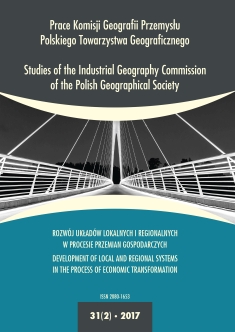Prescription for Abnormal Distribution and Interdependence of Observations Using Randomization Tests and Mantel Correlation Coefficient – the Example of Human Resources Distribution in the Regions of France
DOI:
https://doi.org/10.24917/20801653.302.12Keywords:
France, human capital, Mantel test, randomization, R-package, statistical methodsAbstract
Using statistical methods in geographical research, researchers are often faced with the problem that their data do not comply with the assumptions required by a number of statistical tests. For example, many parametric statistical tests are based on the assumption of normal distribution of data. In practice, however, this supposition is often not met, and the serious deviation of data distribution from the normal distribution (e.g., J-shaped distribution) can lead to quite absurd values of confidence limits (for example, the confidence interval). Another common problem with data from geographical research is the interdependence of observations. Mutual correlation of data can, for example, reflect the spatial distance between the places where that information was obtained. Therefore, the results of measurements from sites located in close proximity to each other may be more alike than observations from places more distant from each other. In such a situation, estimated p-values for tests investigating the relationships between variables (e.g. Pearson correlation) can be very confusing, because the “classical” statistical methods assume independence of the variables. In these situations, the researcher can use randomisation tests that allow him to “get around” the assumptions of normal distribution and independence of observations. These methods, along with the ability to perform complex calculations using computer tools, are becoming increasingly popular among researchers. The article explains the logic of randomisation tests and two examples of their use: estimating the interval for the mean and calculating Mantel correlation along with testing its significance. Calculations have shown that in both cases, disregard of the statistical assumptions leads to false results. In order to illustrate these statistical methods, data used in this paper show the volume and share of human resources in science and technology (HRST) in regions of France and the pace of changes in these values over time and space. Calculations were conducted using the free statistical software R Project and Excel spreadsheet.
Downloads
Metrics
References
Bruin, J. (2006) (2015, 11 stycznia). Newtest: command to compute new test, UCLA: Statistical Consulting Group. Pozyskano z: http://www.ats.ucla.edu/stat/stata/ado/analysis/
Czapliński, P. (2008). Problematyka badawcza przemysłu w geografii na tle nauk ekonomicznych, Prace Komisji Geografii Przemysłu Polskiego Towarzystwa Geograficznego, 11, 46–52.
Davison, A.C., Hinkley, D.V. (2008). Bootstrap Methods and their Application. Cambridge Series in Statistical and Probabilistic Mathematics. Cambridge: University Press.
Dorocki, S., Borowiec, M. (2011). Rola kapitału ludzkiego w procesie kształtowania innowacyjności układów regionalnych Francji. W: B. Namyślak (red.). Przekształcenia regionalnych struktur funkcjonalno-przestrzennych. Wrocław: Instytut Geografii i Rozwoju Regionalnego. Uniwersytet Wrocławski, 215–230.
Dziewoński, K. (1965). Zagadnienia integracji analizy kartograficznej i statystycznej w badaniach geograficznych. Przegląd Geograficzny, 37(4), 585–597.
Fortin, M., Gurevitch, J. (2001). Mantel Tests: Spatial Structure in Field Experiments. W: S.M. Scheiner, J. Gurevitch (red.). Design and Analysis of Ecological Experiments. Nowy Jork: Chapman & Hall, 308–315.
Janc, K. (2006). Zjawisko autokorelacji przestrzennej na przykładzie statystyki I Morana oraz lokalnych wskaźników zależności przestrzennej (LISA) – wybrane zagadnienia metodyczne. W: T. Komornicki, Z. Podgórski (red.). Idee i praktyczny uniwersalizm geografii, Dokumentacja Geograficzna, 33, 76–83.
Olejnik, A. (2013). Wybrane metody testowania modeli regresji przestrzennej. Przegląd Statystyczny, 60(3), 381–393.
Wibig, J. (2013). O współczynniku korelacji liniowej raz jeszcze. W: K. Jarzyna (red.). Zastosowanie metod statystycznych w geografii. Kielce: Instytut Geografii Uniwersytetu Jana Kochanowskiego w Kielcach, 47–61.
Downloads
Published
How to Cite
Issue
Section
License
Articles are published under the terms of the Creative Commons License (CC BY-ND 4.0; Attribution– NoDerivs).

